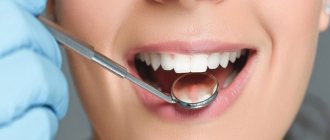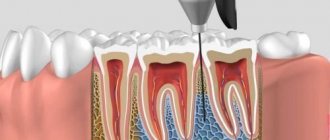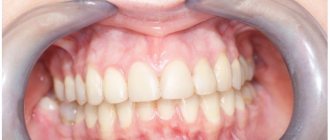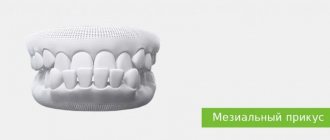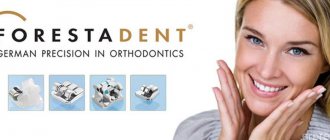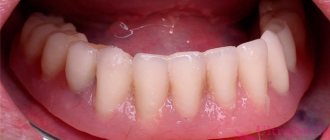There are cases when it is not possible to correct a malocclusion using braces and aligners, when it is not the pathological location of the teeth, but skeletal disorders in the jaws. Such as mesial or distal bite, when the lower jaw is located in front of the upper jaw or vice versa. In such situations, it is impossible to correct the bite using a conservative method. We resort to radical surgery to correct the bite - we correct the bite surgically, thereby lengthening or shortening the jaws and chin. Such operations can improve the profile of the face, make it more symmetrical and, as a fact, more attractive.
It should be clarified that operations to correct the bite are carried out during the period of completion of the formation of the jaws. Until the age of 18, the need for surgical intervention is decided strictly on an individual basis. Such operations are carried out if there are very serious deviations that are not amenable to other types of treatment.
In old age, these surgical interventions are recommended to be performed up to 60 years of age. If the patient is older, then the need for surgical intervention is decided individually, taking into account concomitant diseases.
In Krasnodar, surgical interventions to correct bites are carried out in many specialized clinics and hospitals.
How is a bite corrected surgically?
What is surgical orthodontics and when is it performed?
Radical surgical orthodontics is used to correct the bite when a change in the position of the teeth will lead to a deterioration in the patient’s condition, increased muscle tone, and, as a consequence, neurological disorders. With a mesial position of the lower jaw, or with its distal position, with pathological asymmetry of the face, when as a result of this the quality of life changes.
When a patient has a diction disorder that qualitatively disrupts his social life and alternative treatment does not lead to results, radical surgery is resorted to.
This manipulation is not performed in our clinic for a number of blood pathologies, for hormonal diseases, for immunodeficiencies, for children under 18 years of age, for diseases of a psychological nature.
The procedure itself is a surgical intervention into bone tissue. This manipulation is called osteotomy. The surgeon augments the bone or reduces its volume, makes an incision in the jaw, and can change the shape of the chin.
Minor defects
If there are anomalies in the size and shape of the front teeth, the position can be corrected without the intervention of an orthodontist. Veneers and crowns change the shape, close diastemas (gaps between the front teeth), tremata (gaps between other teeth), and visually increase the size of the teeth. Increasing the height of the bite has a positive effect: the lower jaw that has moved back returns, this reduces the load on the temporomandibular joint. The pain and clicking go away. Facial proportions are restored and posture is straightened.
Indications for surgery
Today, patients themselves can insist on orthodontic surgery, or the doctor insists on this type of surgical intervention.
Indications for radical surgery to correct the bite are:
- significant underdevelopment of the lower jaw, or an upper jaw that is too forward
- if the teeth do not close in the lateral or anterior sections, the so-called open bite, which interferes with normal chewing of food
- if there are abnormalities in the development of the chin
- when the patient has significant diction problems
- if the patient received injuries that led to jaw deformities.
Diagnostics
Before performing the operation, it is necessary to carry out a diagnosis. This will allow the doctor to see the full picture and decide whether surgery is necessary. Diagnostics involves:
- Undergoing an X-ray examination. Specialists take pictures of the upper and lower jaw. From X-rays, the specialist receives detailed information about the location of the jaws and teeth of a particular patient.
- Impression of teeth. Specialized materials are used.
- Consultation with a maxillofacial surgeon.
Preparation
Preparation for the operation to correct the bite is carefully carried out by our doctors; all plaque and tartar are removed; for this, a qualified hygienist will perform a series of manipulations to remove supragingival and subgingival deposits.
A general practitioner and a surgeon will treat caries and its complications, and remove teeth that have been destroyed at the root. In our clinic you can undergo all the necessary examinations before surgery and have a computed tomogram done on the latest tomograph. The dentist-surgeon together with the orthodontist will plan the future result and make a template.
So what exactly does the cost of a braces system depend on?
Let's start with something simple.
In a simple metal brace system, the braces are metal, the arch is fixed with “ligatures” - silicone rings. (Ligatures also come in both transparent and colored, but this does not affect the price.)
In a self-ligating brace system, the braces are also metal, but the arch is fixed with a “lock” on the bracket, which allows you to fix the arch more firmly, and therefore work faster, i.e. correct the bite. At the same time, the bracket itself is slightly smaller.
For those who want to visually hide the presence of a brace system on their teeth, there are so-called “aesthetic” brace systems. These are ceramic - “white”, sapphire - “translucent” and a slightly more affordable option, combined braces, i.e. In such a bracket system, the front six brackets located in the “smile zone” are ceramic or sapphire, and the rest are metal.
All aesthetic brace systems can be either simple (the arch is fixed with “ligatures” - silicone rings) or self-ligating (the arch is fixed with a “lock” on the bracket).
Progress of the operation
Surgical correction of the bite is carried out in our clinic under general anesthesia under the guidance of an experienced chief physician and anesthesiologist-resuscitator and orthodontist. The duration can take from 15 minutes to 4 hours in complex cases. The operation itself includes the surgical stage itself, when access to the bone is carried out surgically through soft tissue in order to correct its position. The surgeon performs manipulations to reduce or increase the volume of bone tissue, or to displace it using a special surgical set and elements for fixing the bone (various splints, screws).
If the patient’s condition allows and there is a need, braces are installed immediately after surgery. After surgery, a fixing bandage is applied to the face. Sutures are placed on soft tissues, and the wound surface is treated.
In complex clinical cases, due to the proximity of other organs to the operated area, we involve the appropriate specialists - ophthalmologists, plastic surgeons, otorhinolaryngologists.
Since the operation is performed exclusively under general anesthesia, it is painless for the patient, under constant monitoring of the condition of vital organs and systems by an anesthesiologist.
Smile in a Million
— It turns out that lingual braces are the most comfortable?
- I wouldn't say that. Lingual braces have the advantage that they are not visible, but from a therapeutic point of view this is a more labor-intensive and complex process. And, if it is not important for the patient which braces to fix, I will recommend him new generation braces - Damon 3 - System. They are quite aesthetic because the half of the bracket is transparent and there is no ligature, reduced size of the bracket, low friction forces in the system, less traumatic effect on the moved teeth and surrounding tissues, which greatly reduces the duration of treatment, less pain, more comfort for the patient, which generally improves the quality and effectiveness of treatment. Now modern technologies are emerging that allow the use of a lingual system, manufactured individually for each patient in a special laboratory. - But it probably costs much more? - More expensive or cheaper - the concepts are very vague. Everyone decides this for themselves. If parents try to cure their child, to give him a beautiful smile for life, they do not save, but, on the contrary, invest in their child, in his comfort, in his future. Otherwise, a complex person may grow up, embarrassed to say a word, hiding his smile... A beautiful smile is a psycho-emotional factor, a health factor, and a social factor. Investment in orthodontic treatment is the best investment in life, health, beauty, image, individuality. The leading role in a person’s appearance belongs to the face, and on the face – a smile. If it is believed that the eyes are the mirror of the soul, then a smile is a reflection of the heart. Back
Recovery period
The recovery stage after surgery is the longest. Since maxillofacial surgery, which is performed to restore malocclusions and straighten teeth, with distal occlusion in adults, the jaw often has to be broken, which is a complex surgery, and the recovery process in such patients takes longer and is quite painful.
In the postoperative period, there may be an increase in temperature, pain, and swelling of the face. It is important to strictly follow the recommendations that the surgeon gives after the operation.
The doctor will prescribe you a number of medications, give you all recommendations on nutrition, hygiene, and prescribe follow-up examinations and suture removal.
The healing period depends on the extent of the intervention and, as a rule, lasts from several weeks to 2 months.
Our specialists are in touch with patients around the clock, which allows us to reduce postoperative complications to zero.
Rehabilitation
After surgical correction of the bite, the patient should be prepared for long and complex rehabilitation. Immediately after the operation, a splint is applied to the jaw, and the entire head is covered with a bandage, which prevents bone displacement and also reduces swelling. The bandage is removed after a few hours, and the splint can be removed only after two weeks of rehabilitation.
Features of the recovery period:
- If you have a splint, you should not open your mouth wide, actively move your jaws, blow your nose sharply, close your nose when sneezing, or chew food vigorously;
- taking antibiotics for 5–7 days;
- sutures are removed after 10–14 days;
- screws - fasteners are removed after 4 months.
In the first days, bruising, difficulty speaking, difficulty eating, pain in the jaw and headaches are possible. There may be numbness in the area where the jaw was cut. Gradually all symptoms disappear. Complete rehabilitation takes from 1 to 3 months. After complete recovery, you can evaluate the result.
Before and after results
Results before and after surgery will vary significantly. Depending on the scope of the surgical intervention, the type of pathology or injury, it depends on when the first results of the operation can be seen.
If the surgical intervention was extensive, screws, screws, pins were installed, then the result can be seen in a couple of months. The patient undergoes CT and TRG to assess changes in jaw position.
If screw fastenings were used during the operation, they are removed after 3-4 months, after which the result of the surgical treatment is finally assessed.
The final result of the operation depends both on the professionalism of the surgeon and on the patient’s compliance with all the doctor’s recommendations. The correct behavior of the patient during the rehabilitation period affects the final result of the surgical intervention.
How much does orthognathic surgery cost in Krasnodar?
The cost of the operation includes the operation itself and the post-operative period.
Orthognathic surgery without a postoperative period costs about 200 thousand rubles. The postoperative period will cost about 100 thousand rubles.
Patients in most cases are satisfied with the surgical intervention. They note an improvement in their quality of life. But for some, the disadvantage of this type of operation is the high cost. Since this type of operation is a planned operation of moderate severity, it is possible to carry it out under compulsory medical insurance. The waiting period can be more than 6 months.
